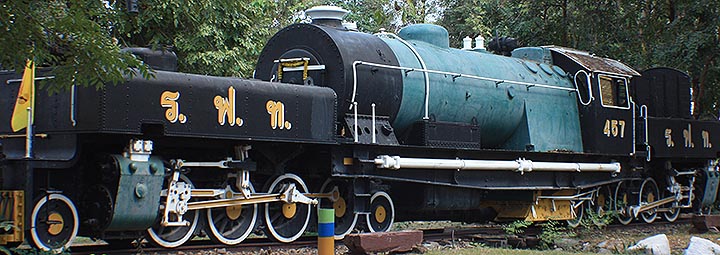And if you said to yourself “minus 16” well, I’m sorry, it’s not an arithmetic question.
It’s a story about something that caught my eye when I was in Kanchanaburi last month; along with a feeling of amazement at how you can found out anything about anything on the web, however trivial. And I have to confess, this is extremely trivial.
I don’t know why, because I wouldn’t really call myself a railroad buff, but when I’m travelling around I seem to be drawn to train stations. I guess if it has an engine and wheels, I’m interested.
See…

 Anyhoo, outside Kanchaniburi station I found this…
Anyhoo, outside Kanchaniburi station I found this…

“That looks strange” I thought, so I took a photograph. For starters it’s big. And Thailand’s railway system is not. The track is only one meter gauge. My first thought was “there’s no way a locomotive that size would be able to run on narrow twisting tracks.” Oops, no, that was my second thought.
So that’s where the internet comes in. At least I know enough about locomotives to know what I was searching for. They are categorized by their wheel types and locations. A simple locomotive with a couple of small wheels front and back and four big driven wheels in the middle would be called 2-4-2.
Now, you can see from my photo, this thing has lots of wheels. In fact it looks like two locomotives stuck together. That’s where the 2-8-2 + 2-8-2 comes from. It’s like two locomotives each with two small wheels front and back and eight driven wheels in the middle, that have somehow been mated.

Hence, my starting point was to research 2-8-2 locomotives. Apparently they are known as “Mikado” and the two stuck together “Double Mikado.” Now, about all I know about the Mikado – since my parents were into amateur operatics – is characters with names like Yum-Yum, Nanki-Poo and Poo-Bah who lived in some place called Titipu. I couldn’t make this stuff up if I tried.
Next I learned that this type of locomotive is known as a Garratt type. I’ll let Wikipedia explain…
A Garratt is a type of steam locomotive that is articulated into three parts.
Its boiler is mounted on the centre frame, and two steam engines are mounted on separate frames, one on each end of the boiler. Articulation permits larger locomotives to negotiate curves and lighter rails that might restrict large rigid-framed locomotives.
Many Garratt designs aimed to double the power of the largest conventional locomotives operating on their railways, thus reducing the need for multiple locomotives and crews.
So that answers the question as to how they can be used on narrow gauge tracks. The thing is in three parts. To be honest, I can’t figure where it’s articulated. To me it looks like one humungous chunk of steel. If I’d known then what I know know now, I’d have looked closer.
Having discovered more than I thought possible, I wondered if I could learn more about this specific locomotive. Ha! No problem…
It was one of only two built for the Royal State Railways of Thailand in 1936 by a German company called Henschel. It was used until 1964 and then hidden away until someone realized its importance in terms of railroad history, after which it was restored and put on display in Kanchanaburi.
Which, to be honest, I find about as uninteresting as you do. What amazes me is that I could find out so much information about something that at first glance looks like any old steam locomotive.
And now I return you to our regularly scheduled programing.
